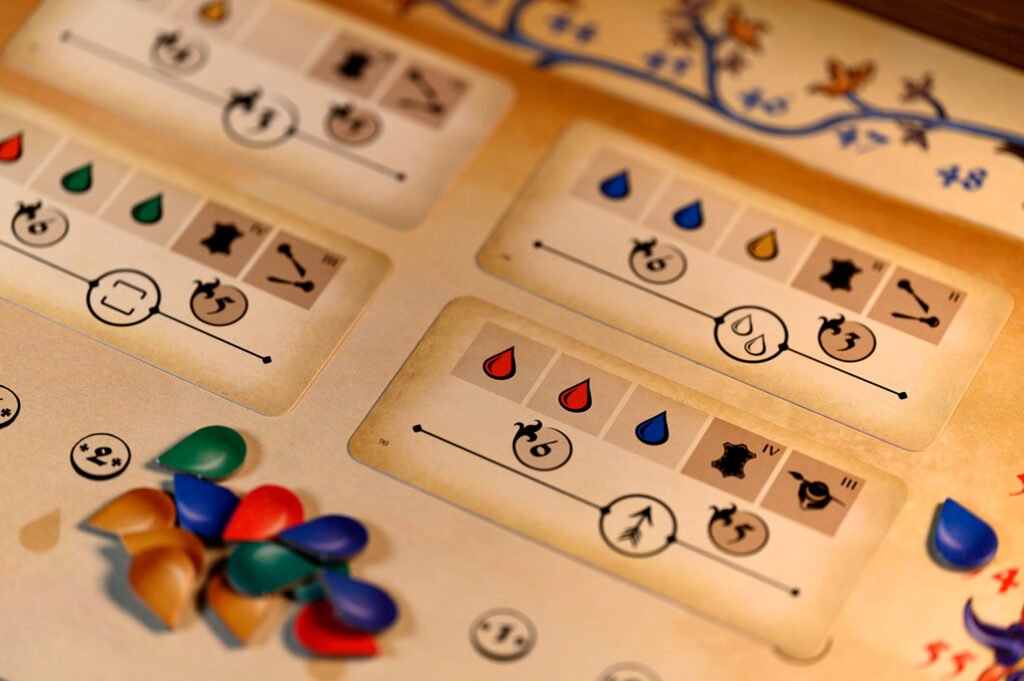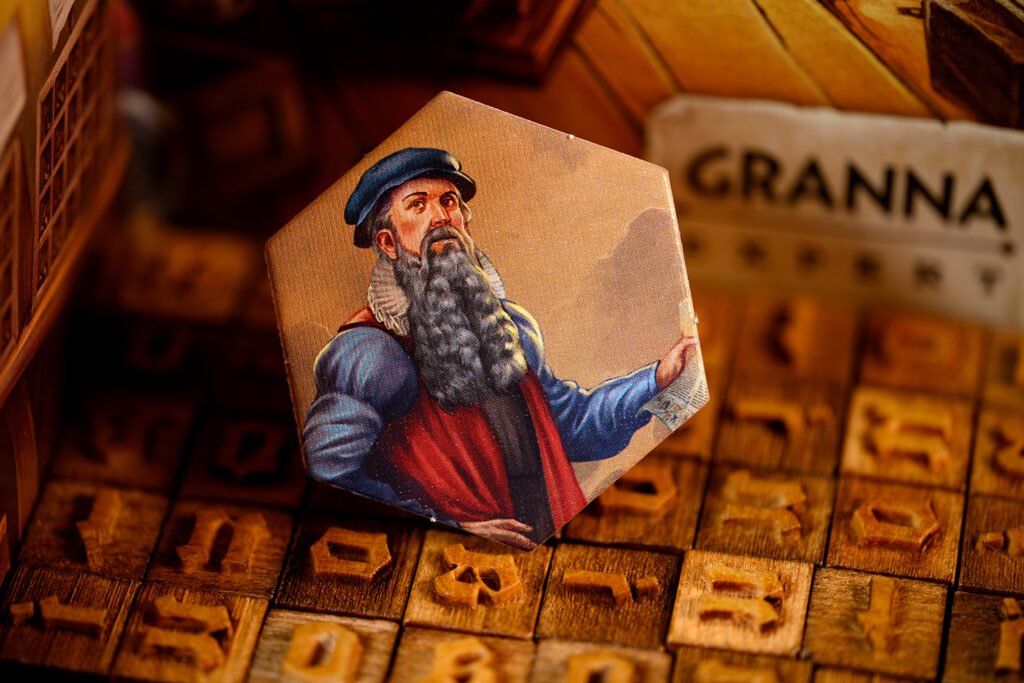Katarzyna Cioch and Wojciech Wisniewski, Gutenberg’s authors, discuss their way to create one the the most exciting euro games that lauched at Essen Spiel 2021. Welcome to third part of Designer Diary.
Specialties
In the beginning, there were quill pens, paper, candles and inkwells. And as calligraphy developed into book printing, cloth, leather and metal binding appeared. These were simply ways to decorate books. Our attention was focused on finding various interesting ways to distribute resources from the board. There were cards, dice, boredom, tokens, bowls, total lack of elegance, cards, dice, cards again, wgrhhhh… until we realized that we were simply solving the wrong problem – how resources were distributed wasn’t important if resources had exactly the same role in the game as inks. A breakthrough in the game mechanisms was the concept of specialty skills that are permanent, and the higher a given specialty’s level, the more points a player receives for fulfilling an order that requires this specialty. We introduced a development track, bonuses, and a new scoring method. We spent a lot of time and testing on the visualization of our ideas and iconography, because players had perceptual problems scoring fulfilled orders. Each layer of the game (each space on the board) had a different meaning, and we started discussing the possible player strategies. These strategies became the main axis of balancing the game. We also knew that specialties needed historical terms, but in the prototype phase, like true eurogame fans, we did not hesitate to call them blue, white, brown and black. In the final version of the game, however, the specialties you will develop in your printing houses are typesetting, woodcutting, binding and illumination.

Playtesting and Playtesters
Kasia and I are both members of playtest groups (Prototypy and Pamper), and we know how important – and tedious – a process it is to test a game at various stages of its development. Sometimes it is crucial to select a group of testers for the specific problem being solved. Initially, we terrorized only our nearest and dearest with our broken prototypes, hoping that the strength of our bonds would survive this experience. Once the game was playable, we started showing it to our playtest groups, aiming to improve the player experience with them as much as possible. From time to time, we also enlisted the help of friends, to monitor how our game is perceived by people seeing it for the first time, instead of “veterans”.

Due to the pandemic, most playtesting was done online with Tabletop Simulator. With feedback from testers scattered all over Poland, we developed Gutenberg and solved problems that appeared in the game. Sometimes, playtesting was our second full-time job. After each test, we also wrote detailed reports to archive our observations, organize our thoughts, and exchange conclusions with each other. The most interesting, from my point of view, was one of the last playtests. I gave the players a prototype and instructions, and I simply observed how they played (so-called blind playtesting). It opened my eyes a lot and allowed me to see the game – which I thought I already knew very well – from a whole new perspective. I recommend this experience to every designer. Even though I have played and watched about a hundred playtests of this game, I am still happy to sit down to play Gutenberg, which I count as a success.

Orders
Orders were present in the game from the very beginning, but they took on various forms. Initially, they were Latin quotations with “holes” that had to be filled with vowel types. We quickly realized that 6 different types were too many for the game, and we reduced the number to 4 (we tried going down to 3, but the game became too “flat”, so we didn’t try further reduction). By the way, there is no “Y” in Latin, so we had to give up that vowel anyway. You learn something new every day. Then we added various mechanisms to decorate printed books. At a certain point, playtesters began complaining about having too little influence on what orders they had to fulfill because their selection was very limited, and the order structure was rigid (for example, I had the appropriate type, but I did not have the right color of inks or the right specialties). At some point, we decided to literally cut orders in half. Yes, you know, with scissors. From then on, players had to take the two parts of the card separately and combine them into one order. The problem of the lack of control was solved – playtesters stopped complaining about their inability to influence what they were supposed to do in the game. One result of this joyfully creative surgery is the rather unusual size of these game cards. This is probably also the reason why Kasia is now working on a game about scissors.
 Polski
Polski English
English Deutsch
Deutsch




